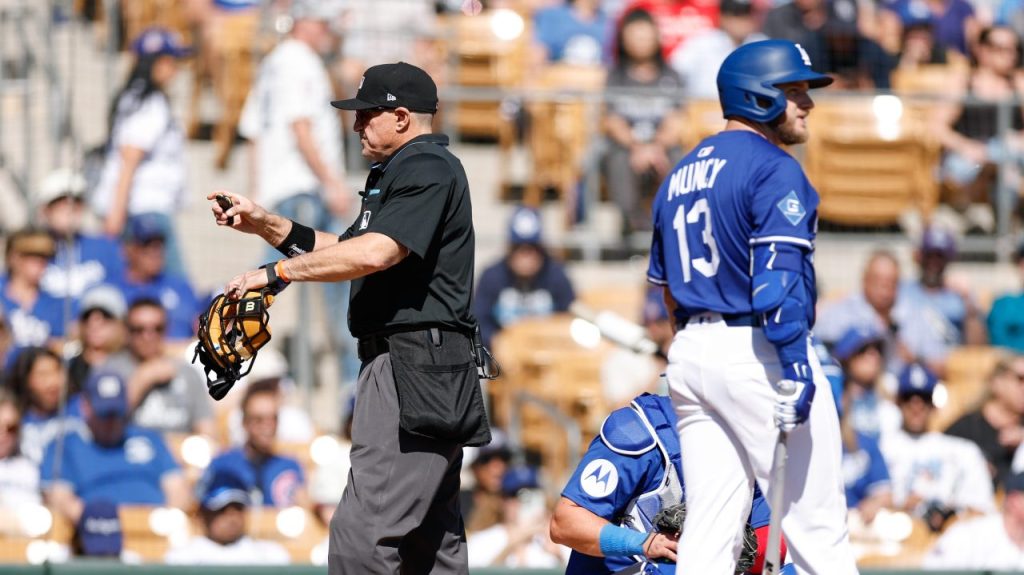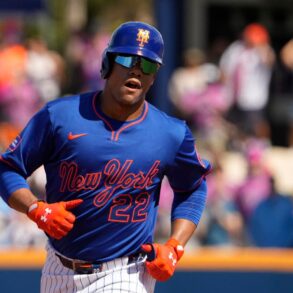
SCOTTSDALE, Ariz. — Major League Baseball had a successful test run debut of its Automated Ball-Strike (ABS) system Friday at Salt River Fields, the spring training home shared by the Arizona Diamondbacks and Colorado Rockies.
Under the ABS system, teams can challenge the home-plate umpire twice each per game to review any ball or strike call. If you’re wrong, you lose it. If you’re right, you maintain that challenge. The D-backs were right on both of their two challenges that afternoon. Later in the game, the Rockies were right on back-to-back pitches.
This was the first Arizona start for Corbin Burnes, the right-hander who signed as a marquee free agent with the D-backs this offseason on a six-year, $210 million deal that includes a player opt-out after the second year. And he was impressed.
“I thought today [the system] was great,” he said.
He had good reason to feel that way. In the top of the first inning, Burnes was having his way with the Rockies. Burnes had whiffed the leadoff hitter, Brenton Doyle, and his 1-2 pitch to Kyle Farmer was called a ball. The pitch was close enough that D-backs catcher Gabriel Moreno questioned it, “but was a little bit hesitant,” Burnes said.
Unlike instant replay challenges that come off the bench from the manager, only the catcher, pitcher or hitter can challenge the umpire’s pitch call by immediately tapping his cap or helmet. The umpire still makes the call, but the Hawk-Eye technology system can be utilized to overrule him.
“He looked at me like ‘should I do it?’ I said, ‘Go ahead, you’re the one catching. You know the zone better than I do,’” Burnes said. “Good thing he did.”
The strike zone was shown on the scoreboard and revealed the pitch had actually hit the lower left-hand corner. Strike three. Ryan McMahon struck out swinging to end the inning and Burnes’ first D-backs performance.
Burnes, for his part, said he had no change of focus pitching under the ABS than purely the variations of a particular plate umpire’s strike zone.
“I totally forgot about the ABS until I threw that pitch and everyone started yelling. Moreno tapped his head, and it turned out to be a punch out,” he said. “As of today, I liked the ABS. Ask me the next time I go out.”
The ABS system has come to a ballpark near you this spring: 13 of them, in fact—five in Arizona and eight in Florida. The five in Arizona are installed in complexes shared by two teams, like Salt River, equipped with the Hawk-Eye tracking system. It’s a big-league dress rehearsal for possible major-league use in all 30 ballparks; the earliest it could be in MLB games would be the 2026 regular season.
The system has been tested in the minor leagues in some form since 2021 and also in select Arizona Fall League parks. It’ll be back in Triple-A this season; the minor leagues have utilized three challenges per team per game.
“I think we’re still far off from using it in the big leagues,” Burnes, 30, said. “Talking to guys who’ve played with it in the minor leagues there’s still some issues. Given a small sample in spring training, we’ll give MLB an idea of what bugs still need to be ironed out.”
The main issue in the minors has been the accuracy of Hawk-Eye on borderline pitches, which MLB has addressed by continuing to tweak the technology. The camera system has been improved to better track ball movement.
But to Burnes’ point, young players have been weaned on it and are accustomed to it, while a number of crusty veterans would have to adjust.
Alek Thomas, a 24-year-old D-backs outfielder, has played with ABS since 2021 during his time in their minor league system, including rehab stints because of a left hamstring injury last season.
“It’s cool. I like it,” he said. “I wish we had more challenges. In the minor leagues I tapped my head a lot if I didn’t agree with a call. But in spring training I don’t think I’ll be tapping my head too much.”
In contrast, Justin Verlander, the San Francisco Giants’ 42-year-old right hander with 267 wins, said he had a taste of it last season when he made a rehab start at Houston’s Triple-A Sugar Land club. Like anything he’s asked, Verlander said he has “a lot of opinions about it.”
“I don’t think it’s bad,” he said. “I definitely think it’s going to take some time to get it right, just like everything that’s been implemented in the game. We don’t know the ripple effects of it. But in the end, in big spots everyone wants the call to be right.”
Verlander is old-school enough that he would miss the traditional back-and-forth with the umpires, another complaint from veteran players about utilizing the ABS system.
“[The umpire] sets up, and I have a little margin for error over here. I have none [with the ABS system],” he said. “He likes to call the high one, but doesn’t like to call the low one. That’s the game of baseball. I don’t want to take that away.”
But he also likes having a little bit of control over the strike zone. Last year at Sugar Land, Verlander said he told the catcher to make the appeal.
“I won’t do anything,” he said with a loud chuckle. “Of course, the first one I threw I thought was a strike, I appealed right away.”
Like Burnes, Verlander was happy with the outcome.
“I was right,” he concluded.
This post was originally published on this site be sure to check out more of their content.





